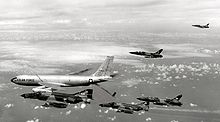Air interdiction
Air interdiction (AI), also known as deep air support (DAS), is the use of preventive
A distinction is often made between tactical and strategic air interdiction, depending on the objectives of the operation. Typical objectives in tactical interdiction are meant to affect events rapidly and locally, for example through direct destruction of forces or supplies en route to the active battle area. By contrast, strategic objectives are often broader and more long-term, with fewer direct attacks on enemy fighting capabilities, instead focusing on infrastructure, logistics and other supportive assets.
The term deep air support relates to close air support and denotes the difference between their respective objectives. Close air support, as the name suggests, is directed towards targets close to friendly ground units, as closely coordinated air-strikes, in direct support of active engagement with the enemy. Deep air support or air interdiction is carried out further from the active fighting, based more on strategic planning and less directly coordinated with ground units. Despite being more strategic than close air support, air interdiction should not be confused with strategic bombing, which is unrelated to ground operations.
Air interdiction can cause the physical destruction or
Aircraft
This section needs expansion. You can help by adding to it. (November 2023) |
Post World War II, the UK produced interdictor variants of the English Electric Canberra jet bomber, B(I)6 and then B(I)8, with four 20 mm autocannon, two wing hard points and able to drop nuclear bombs at low levels
History
This section needs expansion. You can help by adding to it. (November 2023) |
World War II
This section needs expansion. You can help by adding to it. (November 2023) |
Korean War
Cold War
This section needs expansion. You can help by adding to it. (November 2023) |
During the Cold War, the NATO alliance leaned into the concept of air interdiction.[10]"Air interdiction...is essential to the overall effectiveness of the Allies' military forces. Their role in supporting operations, on land and at sea, will require appropriate long-distance airlift and air refuelling capabilities. "[10]
Vietnam War

Iran-Iraq War
Both the
The IQAF's interdiction efforts peaked during the first 45 days of the war, but later declined to more sporadic missions, increasing in conjunction with major offensives. Interdiction by the IIAF was more sustained through late 1980 but after mid-January 1981 also declined. While both sides caused considerable damage on the other, with the Iranians arguably achieving more, neither interdiction effort was particularly effective nor did they play a factor in the outcome of the war. Both sides pulled back their air forces to avoid mounting losses and with the reasoning that, while they might not play a role in winning the war, they could still be used to avoid defeat.[11]
Gulf War 1990-1991
21st Century
See also
- Blockade
- No-drive zone
- Ground attack aircraft
- Interdictor
References
- ^ Mark (1995), p. 1-6
- ^ Chun (2001), pp. 131–132
- ^ Mark (1995), pp. 401–405
- ^ Sallagar 1972, p. 5.
- ^ a b Frieser et al. 2007, p. 1151.
- ^ official website."Operation Strangle". United States Air Force. Archived from the original on 2008-05-16. Retrieved 2008-04-30..
- ^ "World Battlefronts: BATTLE OF ITALY: Operation Strangle" Time magazine, Monday, May 8, 1944.[1] Accessed 5 July 2008.
- ISBN 0-8240-4445-2.
- ^ Futrell, pp. 471 - 474.
- ^ a b NATO. "The Alliance's 1991 Strategic Concept". NATO. Retrieved 2023-11-21.
- ^ a b Bergquist (1988), p. 61-62
- ^ a b "New air missions attack Kadhafi troops: Pentagon". AFP. 28 March 2011. Archived from the original on 17 February 2013. Retrieved 29 March 2011.
- ^ "Ellsworth Airmen join Operation Odyssey Dawn". Rapid City Journal. 29 March 2011. Archived from the original on 2 April 2011. Retrieved 30 March 2011.
- ^ "DOD News Briefing with Vice Adm. Gortney from the Pentagon on Libya Operation Odyssey Dawn". U.S. Department of Defense (Public Affairs). 29 March 2011. Archived from the original on 15 October 2012. Retrieved 29 March 2011.
Bibliography
- ISBN 9783421062352.
- Mark, Eduard (1995). Aerial Interdiction: Air Power and the Land Battle in Three American Wars. DIANE Publishing Company. ISBN 9780788119668.
- Chun, Clayton (2001). Aerospace Power in the Twenty-First Century: A Basic Primer. Air Force Academy Colorado Sprints. ISBN 9781428990296.
- Bergquist, Ronald E. (1988). The Role of Airpower in the Iran-Iraq War. Air University Press.
- Sallagar, F M (February 1972), Operation 'Strangle', (Italy, Spring 1944): A Case Study of Tactical Air Interdiction (PDF), The Rand Corporation, retrieved 5 July 2008
External links
- Air Interdiction, by Clifford Krieger. Aerospace Power Journal, Spring 1989.
- DOD dictionary definition of air interdiction.

